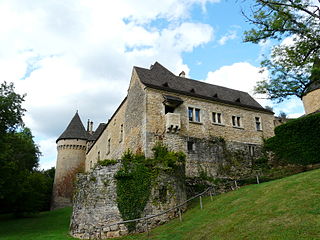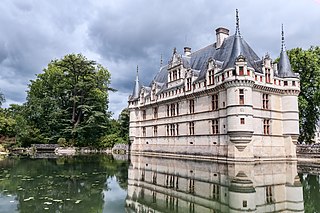The Château de la Faye is a French castle located in Auriac-du-Périgord, in the Dordogne department of France. [1]

Auriac-du-Périgord is a commune in the Dordogne department in Nouvelle-Aquitaine in southwestern France.

Dordogne is a department in Southwestern France, with its prefecture in Périgueux. The department is located in the region of Nouvelle-Aquitaine between the Loire Valley and the Pyrenees and is named after the river Dordogne that runs through it. It corresponds roughly with the ancient county of Périgord. It had a population of 416,909 in 2013.

France, officially the French Republic, is a country whose territory consists of metropolitan France in Western Europe and several overseas regions and territories. The metropolitan area of France extends from the Mediterranean Sea to the English Channel and the North Sea, and from the Rhine to the Atlantic Ocean. It is bordered by Belgium, Luxembourg and Germany to the northeast, Switzerland and Italy to the east, and Andorra and Spain to the south. The overseas territories include French Guiana in South America and several islands in the Atlantic, Pacific and Indian oceans. The country's 18 integral regions span a combined area of 643,801 square kilometres (248,573 sq mi) and a total population of 67.3 million. France, a sovereign state, is a unitary semi-presidential republic with its capital in Paris, the country's largest city and main cultural and commercial centre. Other major urban areas include Lyon, Marseille, Toulouse, Bordeaux, Lille and Nice.
The castle was originally a simple defensive tower built in the 13th century for the defence of Montignac. Towers were later added on the south side—the one on the left in 1359, and the one on the right in the 15th century. [2] [3] The castle is recorded in 1476 as the Faya Fortalitium.

Montignac, also called Montignac sur Vézère or Montignac-Lascaux, is a commune in the Dordogne department in Nouvelle-Aquitaine in southwestern France. It is a small town situated on the Vézère river and has been the capital of the canton of Montignac since 1790. In 2015 it became the capital of the newly created Canton de la Vallée de l'Homme. The poet Pierre Lachambeaudie (1806–1872) was born in the village.
The dwelling portion of the structure dates from the end of the 15th century, consisting of three levels. A tower, which is highlighted by an arched door opening onto the stairs, was added in the 16th century. [4] [5] In the 18th century there were alterations to the roof, including skylights.

A skylight is a light-transmitting structure that forms all or part of the roof space of a building for daylighting purposes.
It is today a listed monument. [6]
























